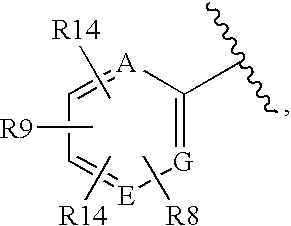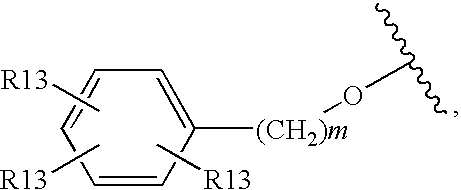Glucagon Receptor Antagonists, Preparation and Therapeutic Uses
- Summary
- Abstract
- Description
- Claims
- Application Information
AI Technical Summary
Benefits of technology
Problems solved by technology
Method used
Image
Examples
preparation 1
Racemic 4-(1-Hydroxy-propyl)-benzoic acid methyl ester
[0207]
[0208] To a solution of 4-formyl-benzoic acid methyl ester (3.0 g, 18.3 mmol) in THF (10 mL) at 0° C. is added ethylmagnesium bromide (2M, 10 mL). After stirring at room temperature for 2 hours, it is quenched with saturated ammonium chloride, extracted with EtOAc. The organic is concentrated to give the titled compound as colorless oil: 2.2 g (62%).
[0209] The following compounds are made in a similar manner:
preparation 2
Racemic 4-(1-Hydroxy-butyl)-benzoic acid methyl ester
[0210]
[0211] This compound is made from 4-formyl-benzoic acid methyl ester and n-propylmagnesium chloride following the general method exemplified in Preparation 1.
preparation 3
Racemic 4-(1-Hydroxy-2-methyl-propyl)-benzoic acid methyl ester
[0212]
[0213] This compound is made from 4-formyl-benzoic acid methyl ester and isopropylmagnesium chloride following the general method exemplified in Preparation 1.
PUM
| Property | Measurement | Unit |
|---|---|---|
| Volume | aaaaa | aaaaa |
| Pharmaceutically acceptable | aaaaa | aaaaa |
| Level | aaaaa | aaaaa |
Abstract
Description
Claims
Application Information
 Login to View More
Login to View More - R&D
- Intellectual Property
- Life Sciences
- Materials
- Tech Scout
- Unparalleled Data Quality
- Higher Quality Content
- 60% Fewer Hallucinations
Browse by: Latest US Patents, China's latest patents, Technical Efficacy Thesaurus, Application Domain, Technology Topic, Popular Technical Reports.
© 2025 PatSnap. All rights reserved.Legal|Privacy policy|Modern Slavery Act Transparency Statement|Sitemap|About US| Contact US: help@patsnap.com



